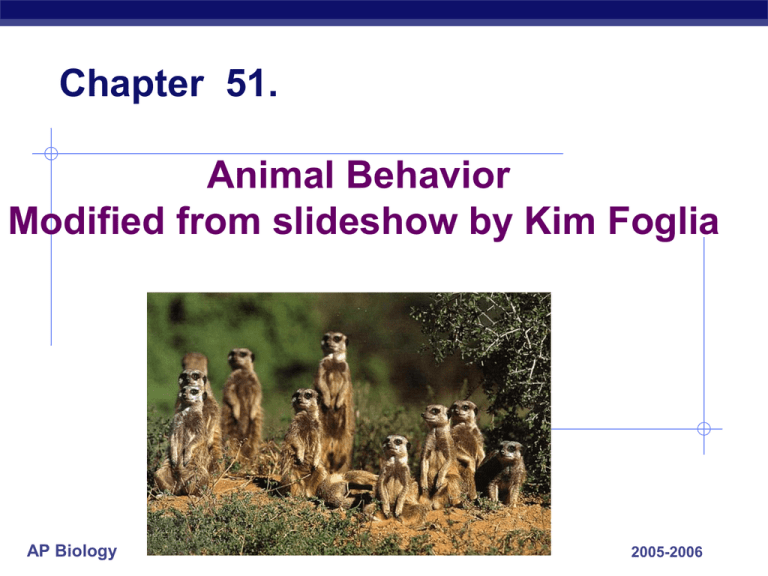
Chapter 51.
Animal Behavior
Modified from slideshow by Kim Foglia
AP Biology
2005-2006
What is behavior?
Behavior
everything an animal does & how it does it
link between animal & its environment
innate = inherited or developmentally fixed
learned = develop during animal’s lifetime
http://i.ytimg.com/vi/oYmzdvMoUUA/0.jpg
http://users.rcn.com/jkimball.ma.ultranet/BiologyPages/L/LearnedBehavior.html
Types of behaviors
Innate behaviors
automatic, fixed, “built-in”
despite different environments, all individuals
exhibit the behavior
triggered by a stimulus
Learned behaviors
modified by experience
variable
triggered by a stimulus
Proximate and Ultimate Questions
Proximate questions: focus on
environmental stimuli that trigger a
behavior, as well as the genetic,
physiological, and anatomical
mechanisms underlying a behavioral
act
Often are “how” questions
Example: How does day length influence
breeding?
AP Biology
2005-2006
Ultimate questions: address the
evolutionary significance of a behavior
Often “why” questions
Ex: Why did natural selection favor this
behavior and not a different one?
AP Biology
2005-2006
Ethology
The scientific study of how animals
behave
Four questions to be answered to fully
understand any behavior:
AP Biology
2005-2006
What is the evolutionary history of the
behavior?
How does this behavior contribute to
the fitness of the organism?
What is the mechanistic basis of
behavior, including chemical,
anatomical, and physiological
mechanisms?
How does the development of the
animal influence behavior?
AP Biology
2005-2006
Innate behavior
Fixed action patterns (FAP)
sequence of behaviors
essentially unchangeable
& usually conducted to
completion once started
sign stimulus
releaser that triggers FAP
AP Biology
male sticklebacks exhibit
aggressive territoriality
attack on red belly stimulus
2005-2006
court on swollen belly
stimulus
Fixed Action Pattern
AP Biology
courtship display in
sticklebacks
2005-2006
Example: FAP
EGG ROLLING IN GEESE
If egg rolls away from the nest, the goose automatically rolls
the egg back to the nest with a repeated, specific action.
When the female notices an egg outside the nest (sign
stimulus), she begins the repeated movement to drag the egg
with her beak and neck.
If, while the goose is rolling the egg back to the nest, the
egg slides off to the side or is removed by an observer, the
goose continues to repeat the stereotypic movements, until
she reaches the nest. She’ll then relocate the missing egg
and begin the process all over again.
FAP in humans?
See video
YAWNING- lasts around 6 seconds
Just try stopping in mid-yawn. You can’t.
Once you begin to yawn, this instinctive,
hard-wired response must run its course,
from beginning to end.
We are triggered to yawn when we see
another
person (or animal) yawning.
Even seeing the word ‘yawn’ can trigger
yawning
OTHER EXAMPLES OF FAP
Mating dances
Gulls pecking red spot on mom’s beak
http://i.ytimg.com/vi/oYmzdvMoUUA/0.jpg
stimulates regurgitation
Human baby grasping
http://en.wikipedia.org/wiki/Fixed_action_pattern
http://lh6.ggpht.com/_bUTjf-hNPDk/R6tc9enBOzI/AAAAAAAAAbA/Fz2Rc68SM8Q/j0408981.jpg
Directed movements
Taxis
change in direction
automatic movement toward (positive taxis) or
away from
(negative taxis) a
stimulus
phototaxis
chemotaxis
Kinesis
AP Biology
change in rate of
movement in
response to a stimulus
2005-2006
Migration
Complex behavior, but still under
genetic control
“migratory restlessness” seen in birds bred &
raised in captivity
Monarch
migration
AP Biology
migrating western sandpipers
2005-2006
Migration
Following ancient fly-ways
navigate by sun, stars, magnetic fields
Bobolink
AP Biology
Summer
nesting
range
Summer
nesting
range
Winter
range
Winter
range
Golden plover
2005-2006
Imprinting
Learning at a specific critical time
forming social attachments
both learning & innate components
Konrad Lorenz was “mother” to
these imprinted graylag goslings
AP Biology
2005-2006
Imprinting
Wattled crane conservation
Imprinting for conservation
Conservation biologists have
taken advantage of imprinting by
young whooping cranes as a
means to teach the birds a
migration route. A pilot wearing a
crane suit in an ultralight plane
AP Biology
acts
as a surrogate parent.
2005-2006
teaching cranes to migrate
Learned behavior
Associative learning
learning to associate
1 feature of the
environment (stimulus)
with another
operant conditioning
trial & error learning
classical conditioning
stimulus &
reward/punishment
QuickTime™ and a
TIFF (Uncompressed) decompressor
are needed to see this picture.
AP Biology
2005-2006
Operant conditioning
Skinner box
QuickTime™ and a
TIFF (Uncompressed) decompressor
are needed to see this picture.
AP Biology
2005-2006
Classical conditioning
Ivan Pavlov’s dogs
AP Biology
connect reflex behavior to associated
stimulus
2005-2006
Habituation
Loss of response to
stimulus
“cry-wolf” effect
learn not to
respond to
repeated
occurrences of
stimulus
AP Biology
2005-2006
Thinking & problem-solving
Do other animals think?
problem-solving
tool use
AP Biology
crow
2005-2006
Do other animals think & plan?
AP Biology
2005-2006
Social behaviors
Contests for resources
develop as evolutionary adaptations
agonistic behaviors
threatening & submissive rituals
symbolic, usually no harm done
AP Biology
2005-2006
Social behaviors
Dominance hierarchy
social ranking within
a group
pecking order
AP Biology
2005-2006
Social behaviors
Altruistic behavior
reduces individual fitness but
increases fitness of recipient
kin selection
Belding ground squirrel
How
AP Biology
can this be of adaptive value?
2005-2006
Social behaviors
Territoriality
AP Biology
nesting in birds
2005-2006
Territoriality
AP Biology
2005-2006
Mating & parental behavior
Genetic influences
changes in behavior in different stages
of mating
pair bonding
competitor aggression
Environmental influences
modifies behavior
quality of diet
social interactions
learning opportunities
AP Biology
2005-2006
Social interaction requires communication
Pheromones
chemical signal that stimulates a
response from other individuals
alarm pheromones
sex pheromones
AP Biology
2005-2006
Pheromones
Female mosquito use CO2
concentrations to locate victims
marking territory
Spider using moth sex
pheromones, as allomones,
to lure its prey
AP Biology
The female lion lures male by spreading sex
pheromones, but also by posture & movements
2005-2006
Pheromones
Human pheromones?
AP Biology
2005-2006
Honeybee
communication
Honey bee dance
to communicate
location of food
source
AP Biology
Bee waggle dance
2005-2006
Auditory communication
Bird song
species identification & mating ritual
mixed learned & innate
critical learning period
Insect song
Red-winged blackbird
mating ritual & song
innate, genetically
controlled
AP Biology
2005-2006
Social behaviors
Cooperation
Pack of African
dogs hunting
wildebeest
cooperatively
White pelicans
“herding” school
of fish
AP Biology
2005-2006
Any Questions??
AP Biology
2005-2006










